Investigating flood resilience perceptions and supporting collective decision-making through fuzzy cognitive mapping
This paper investigates how methods used to model perceptions and measure resilience can help decision-makers create inclusive and proactive flood resilience strategies for communities. Such interventions can only be designed through building a holistic understanding of the options available, and of the preferences and priorities of different stakeholders. This approach goes beyond the traditional appraisals and cost–benefit assessments commonly used by decision-makers. This study is based on research in Lowestoft, a coastal town in England exposed to significant flood risk.
The authors find that combining a mind mapping method with a flood resilience measurement framework enables system-level thinking and inclusive decision-making about flood resilience. The Lowestoft study shows that measures with an immediate and quick impact on reducing flood risk (such as physical protection measures) are likely to be brought up first as a solution in the mental models of decision-makers. Ultimately, this can encourage transformative decisions on the prioritisation of actions and investments.
Explore further
